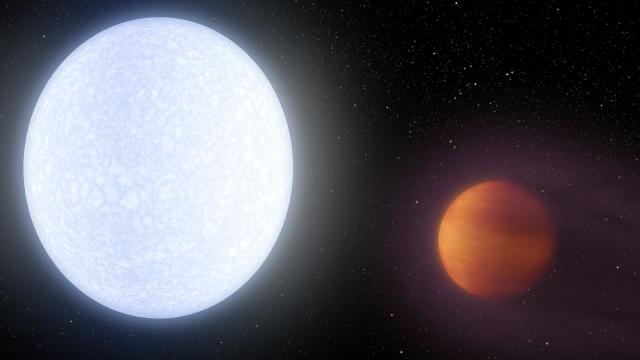Astronomers have documented a bizarre cycle of molecular destruction and rebirth on an ultra-hot, Jupiter-like exoplanet where surface temperatures exceed 4,290 degrees Celsius.
Originally discovered in 2017, KELT-9b has the dubious distinction of being the hottest known exoplanet in the galaxy. This ultra-hot planet is located 670 light-years from Earth, is around 2.8 times more massive than Jupiter, and requires just 1.5 days to complete a single rotation of its host star.
KELT-9b is tidally locked, which means it has a side that perpetually faces its host star, similar to how our Moon’s near side always faces Earth. New research published in The Astrophysical Journal Letters presents evidence showing that hydrogen molecules on KELT-9b’s star-facing side are disintegrating because of the extreme heat. The ensuing bits of busted hydrogen are eventually transported to the exoplanet’s cooler side, where they reform and flow back to the hot side, and the cycle repeats itself, according to the research.
The new paper, led by planetary scientist Megan Mansfield, a graduate student from the University of Chicago, also confirms KELT-9b as being the hottest known exoplanet in the galaxy. Temperatures on the exoplanet’s dayside can reach 4,566 Kelvin (4,293 degrees Celsius), while the cooler dark side is around 2,556 Kelvin (2,283 degrees Celsius).
To map these temperatures, Mansfield and her colleagues used NASA’s soon-to-be-retired Spitzer Space Telescope, which uses infrared light to detect the tiniest heat fluctuations in distant objects. Spitzer data allowed the team to create a temperature profile of KELT-9b, which was observed with the transit method (when a distant exoplanet passes in front of its host star from our perspective on Earth).
Multiple observations of KELT-9b revealed temperatures on both halves of the planet as it rolled into view. Interestingly, the scientists noticed that differences in the temperature between the dayside and nightside weren’t as large as expected, pointing to some kind of atmospheric exchange, or heat flow, between the two sides.
To understand how atmospheric gases and heat flowed around the exoplanet, the researchers turned to computer models. This allowed Mansfield and her team to observe atmospheric behaviour under different conditions. Ultimately, the best model involved the disintegration and reformation of the hydrogen molecules, or the “dissociation and recombination,” as the scientists described the phenomenon.
This latest study reminds us of a similar exoplanet, WASP 121b. But instead of shredding its hydrogen, this hot Jupiter is shredding its water.
Indeed, while KELT-9b represents an extreme case, the researchers have reason to believe this process could be happening elsewhere, even on slightly cooler exoplanets.
“This kind of planet is so extreme in temperature, it is a bit separate from a lot of other exoplanets,” said Mansfield in a NASA press release. “There are some other hot Jupiters and ultra-hot Jupiters that are not quite as hot but still warm enough that this effect should be taking place.”
Weirdly, KELT-9b’s hottest point did not appear to be static; it shifted slightly across the orb. Writing in their paper, the scientists said they don’t fully understand why this is happening, but that “magnetic effects in the planet’s highly ionised atmosphere,” could be the reason. Future research will be required to fully figure out what’s going on.
